Memories for Sale
Selling Vintage Toys at a Retro Toy Show Convention
“Whatcha looking for today?”
That’s my ice breaker line at today’s toy show. Most customers respond with something generic. “Oh, you know,” they say. “A little of this, a little of that.” My follow up is, “So, what do you collect?” That usually gets them talking. More often than not, it’s not anything I have for sale at my table. They came to the show looking for Transformers, or Ghostbusters, or whatever. Even though I don’t have those things for sale, I can — and will — talk about any of them.
To be perfectly honest, I don’t even like selling old toys that much. I just like buying them and, maybe even more than that, talking about them.
In February of 2024 a toy mall opened just a few miles from my house. It’s run like an antique mall. Vendors rent booth space from the owner and a percentage of each sale goes to the house. My wife and I had long daydreamed about running our own little booth at a place like that someday, and the owners of this place were (and are) super rad, so we decided to give it a go. For $100/month we got our own 8-by-6 wall, covered in peg board. A blank canvas, waiting for us to fill.
One of the great things about not knowing rules is that it makes it very easy to break them. We put shelves up in our booth which, we later realized literally none of the other 50 vendors had done. I bought a small flatscreen television and hooked it up to a little device that played random retro commercials from the 70s and 80s nonstop.
And where did our inventory come from? Initially, it came from my personal toy collection. I’ve been buying toys and collectibles for decades and decades. Most of my life, really. “I love that Pee-wee Herman doll,” someone once commented while we were restocking our booth. “Where ever did you find it?” And like so many things in our booth, it came from a store. I bought it new, owned it for 20 years, got tired of looking at it on my desk, brought it up to the booth, and put a price tag on it.
“Arrivederci, Pee-wee.”
I love the above picture because our booth did not look like that for long. As they said in The Stuff, “enough is never enough!” After a month or two of renting a single wall we put the pedal to the floor and expanded the size of our booth. A month or two later, our booth looked like this:
My wife and I like to shop. It’s a fun way to spend time together. We like going to garage sales and thrift stores and antique malls and estate sales. I like buying and collecting things. I like collecting things so much that my wife once dubbed me “the Collector of Collections.” Owning the booth gave us a reason to shop. At estate sales, we became laser-focused. Every old Lego set, every stuffed animal, every action figure became “something we could sell in the booth,” which justified buying them.
For me, emotionally, selling things I just bought is a lot easier than selling things I’ve owned for decades. My wife found a talking Freddy Krueger doll for sale; we bought it, priced it, and put it in the booth. If I had got that thing when I was a teenager it would be incredibly difficult for me to part with. Without the emotional attachment… eh, it’s a toy. Easy come, easy go.

My wife and I loved running our booth… and also, most months, we lost money doing it. The first couple of months after we expanded, we were paying $200/month for rent and selling $100 worth of toys from my personal collection — which is like me giving $100 worth of my personal toys away every month and paying someone another $100 to haul them off. From a business perspective it didn’t make much sense, but from a “something to do” perspective, it was a lot of fun. We got to shop together, and hang out at the store and occasionally talk to customers. For us, it wasn’t a good business but it was a fun hobby.
This month after a full year of trying, we decided to throw in the towel on the booth. My wife is in the process of launching her own shoe business and my work duties are changing. My wife no longer has the time to go shopping for inventory and I don’t have the time to run the booth by myself. After a year, we tapped out. No hard feelings to anyone. We gave it a shot and had a good time in the process.
If you’re thinking to yourself, “man, now they have to get rid of all those toys in their booth,” you’re wrong. We have to get rid of all the toys in our booth plus a garage full of toys we bought to go into the booth. With just things we’ve bought over the past year, we have enough stuff to fill four or five of those booths.
Which explains why today, we’ve purchased tables at a local toy convention.
This is the third toy convention we’ve attended as sellers and the first one of 2025. We don’t really know what we’re doing when it comes to selling toys at a toy convention, but we didn’t know how to run a toy booth either and that didn’t stop us.
At a toy convention, you rent space — 8x8 or 10x10 or something else. Sometimes, like at this show, it costs a little extra to rent tables and chairs. (You can bring your own and save $10/table, if you like hauling, setting up, and breaking down tables.) Some people, the people with large displays, show up the day before and spend an entire day setting up their displays. My wife and I rolled in around 8:30 a.m., 30 minutes before the doors opened to the public.
There are many different categories of sellers. A lot of them, you can tell, are full time toy dealers. They have cool shelves and displays and their stuff is priced accordingly. Some people only deal in specific toys; there’s always a Star Wars booth, and a Funko Pop booth, and a stuffed animal booth. Or two, or three.
And then there are tables like ours, tables that look like a tornado hit an old Toys-R-Us warehouse and deposited a random assortment of things all in one spot. On our table in no particular order were: a Speak and Spell, a pile of NES games, random carded action figures (The Tick, Ali from Karate Kid), a computer mouse shaped like C-3P0’s face, a boxed Pin the Tale on the Donkey board game from the 1960s, and a stuffed Vlasic Pickles stork.
When we started selling toys, my wife shared a catchphrase with me: “a short nickel vs. a long dime.” Sellers use this to mean you can sell something quickly for a little profit (a nickel) or hang on to it for a long time hoping to get top dollar for it (a dime). We have carved out a third category, the less-desirable the “super long penny” — that is, if we make a profit at all.
One of the first things we sold today was a giant Pikachu Squishmallow. I didn’t know what Squishmallows were until we started buying stuff for our booth. If I were to oversimplify them I would say they are large, squishy, stuffed animals that are, for all intents and purposes, this generation’s Beanie Babies. About nine months ago my wife purchased a very large Pokemon Pikachu Squishmallow. I think she paid $20 for it, which was a good deal we were told. We’ve tried selling it for nine months for $80, then $75, then $50, then $40, then “$please take it.” At the last toy show we were at, we tried selling it for $30. Today, my wife sold it for $10. The super-long negative pennies.
Everyone at the show has the eBay app on their phone. The app has a feature that sllows you to take a picture of anything and it’ll immediately pull up that item for sale on eBay. It works amazingly well. Sellers use it to price their stuff and buyers use it to check prices. The app will tell you what an item is currently selling for or, with a couple more presses, what previous ones sold for. The last two carded Ali (Daniel’s girlfriend in The Karate Kid) figures sold for $20 and $40. I marked mine $20.
There was only one person the entire day who gave the figure a second look. One guy, about my age, picked the figure up to look at it. Thirty seconds later, he’s telling me about how he started taking karate lessons after seeing The Karate Kid back in the 80s. Then I tell him that in 1984 at the age of 10, I competed in the local Karate Kid tournament and won third place.
We talk for a good five minutes and when the conversation ends he looks at the figure one last time and sets it down. $20 is too much for him. “I really want you to have that figure,” I say. He asks if I will take $10 and I say yes. Then he asks me if I have change for a $20 and I also say yes.
I have no idea what I paid for that figure. I bought it new, maybe ten years ago. It hung on the wall at my old house; I’ve lived in our current house for six years and it’s been in a storage tub for at least that long. While preparing for the show I opened one of two dozen tubs full of toys I have in the garage, saw it, and brought it. It’s been so long that I don’t remember what I paid for it, which in my brain means I just made $10.
As the man walks away there’s a moment of sadness. I haven’t seen that figure for the better part of a decade and yet, somehow, I’ll miss it. I’ll miss them all — the board games I never got around to playing, the video games that I could play for free on my computer right now if I wanted to, and the piles and avalanche of Star Wars toys I bought in the mid-to-late 90s that every other toy collector bought, too.
My sadness doesn’t last long. Less than a minute later, someone has picked up a copy of "Gauntlet” for the NES and is telling me how much he loved that game. I tell him that I used to own a Gauntlet arcade cabinet and we talk for five minutes about that. He doesn’t buy the game, but the conversation was fun. The next customer wants to talk about Radio Shack. His dad owned two Radio Shack franchise stores, and he’s in search of old Radio Shack remote control cars. I mention that our first computer was a TRS-80 Model III that we bought from Radio Shack, and off we go.
Early in the day, a guy in his 30s walks up with his 10-year-old son. They’re looking at the boxed Speak and Spell on our table. “You know,” I say to the kid, “if it weren’t for that, E.T. would still be stuck here on Earth.” The dad laughs and the kid says, “Who’s E.T.?” I’m reminded that this is not a toy show for kids. It is a toy show for parents, and their parents. The kids bounce from booth to booth looking for Squishmallows and action figures from Fortnite or Five Nights at Freddy’s, but it’s the parents who know who E.T. was. They’re the ones looking at the Star Wars toys, the stuffed Smurfette, the Battlestar Galactica jigsaw puzzle. The most popular items on the table for kids are the basket of free suckers. It’s the Gen-Xers who pick up the plus Pac-Man and carry it away.
We have two more toy shows booked, one for two weeks from now and another in June. With no shortage of toys to sell or stories to tell, we’ll be there. As difficult as it is to see them go, it’s not the hardest part.
The hardest part is not taking the cash we made and spending it on more toys at the show.
(In the time it took me to write this, my wife and I have decided to keep our booth but downsize the space. What can I say… I guess we’re toy dealers after all!)



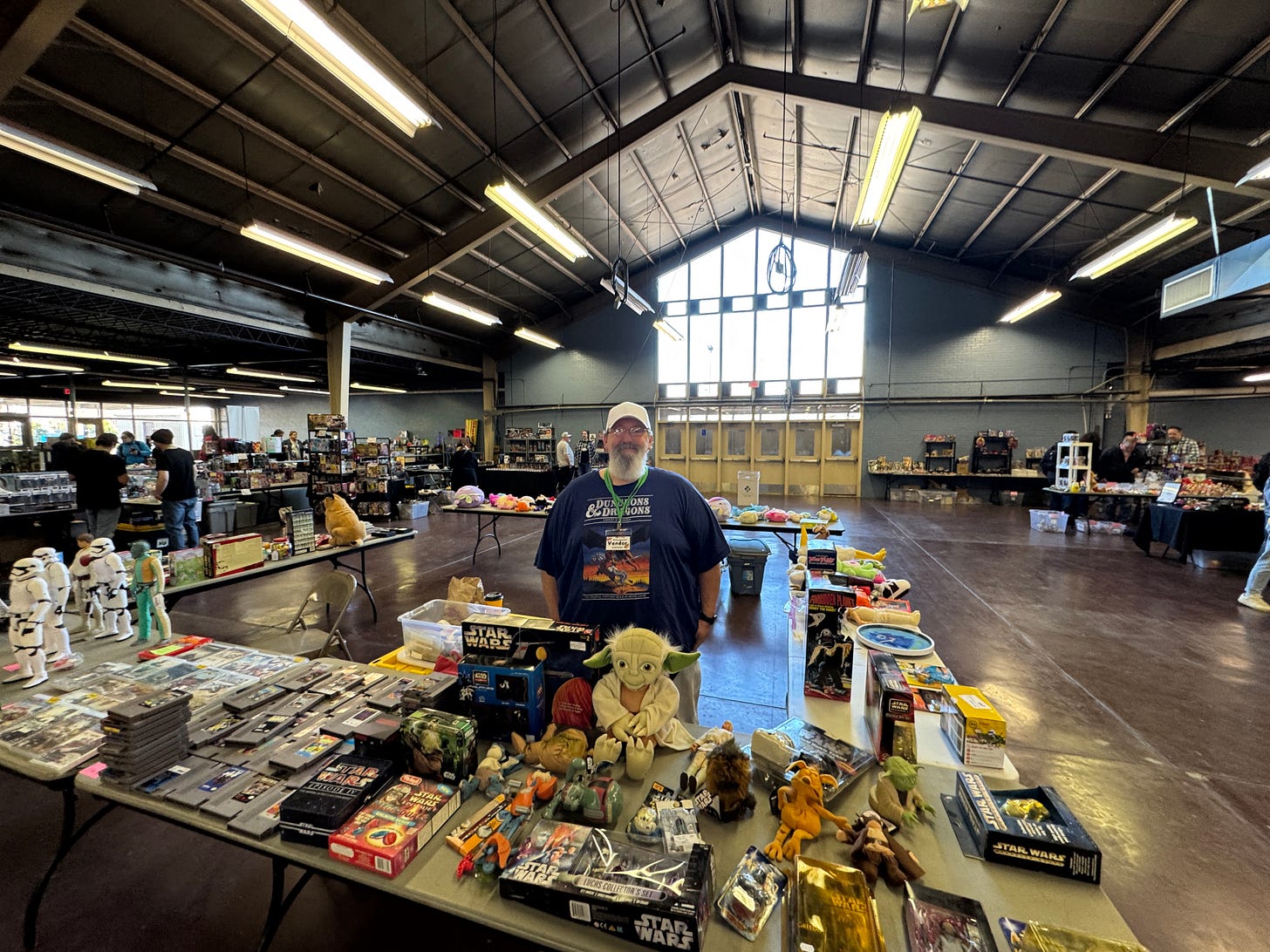
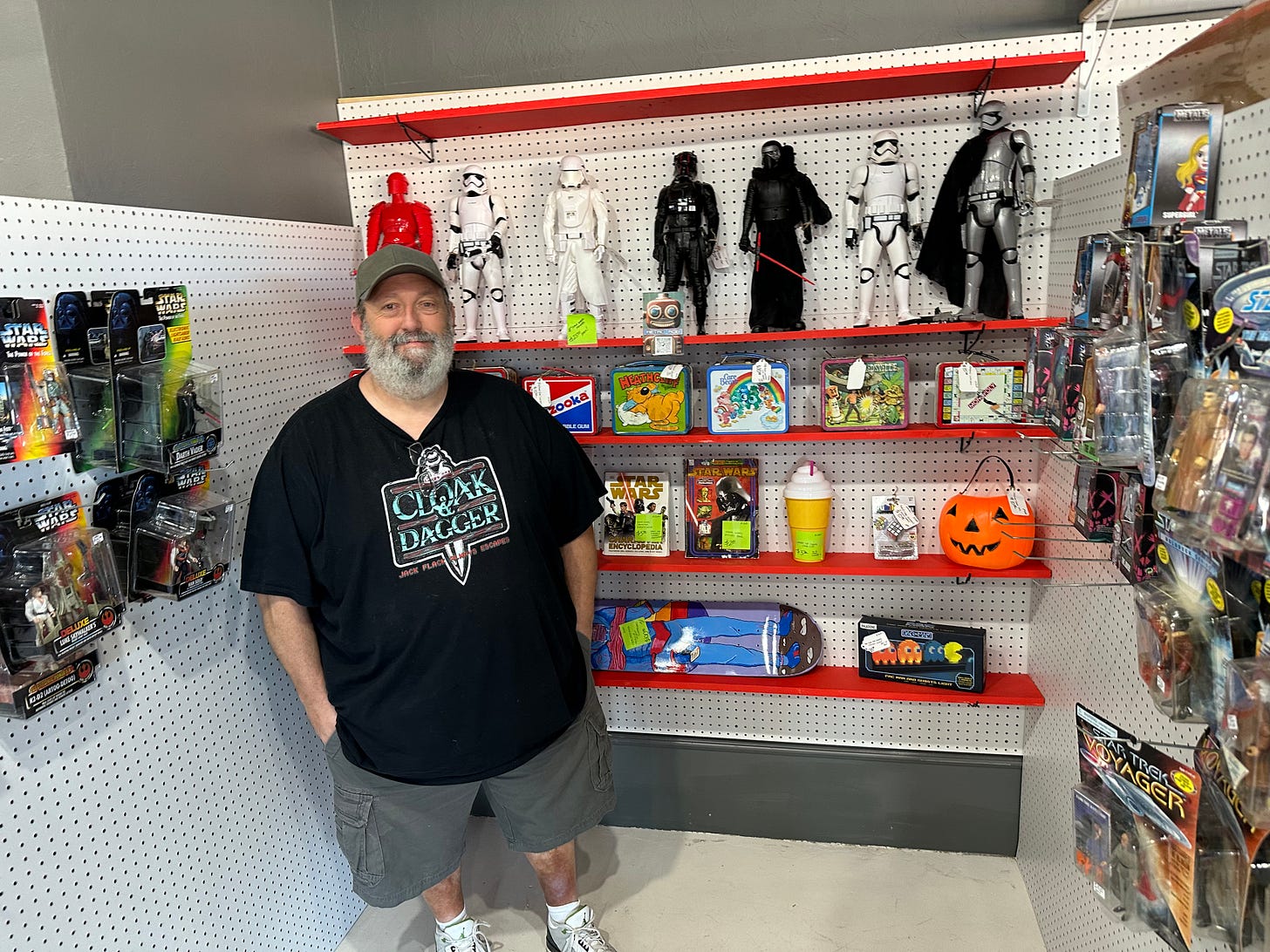
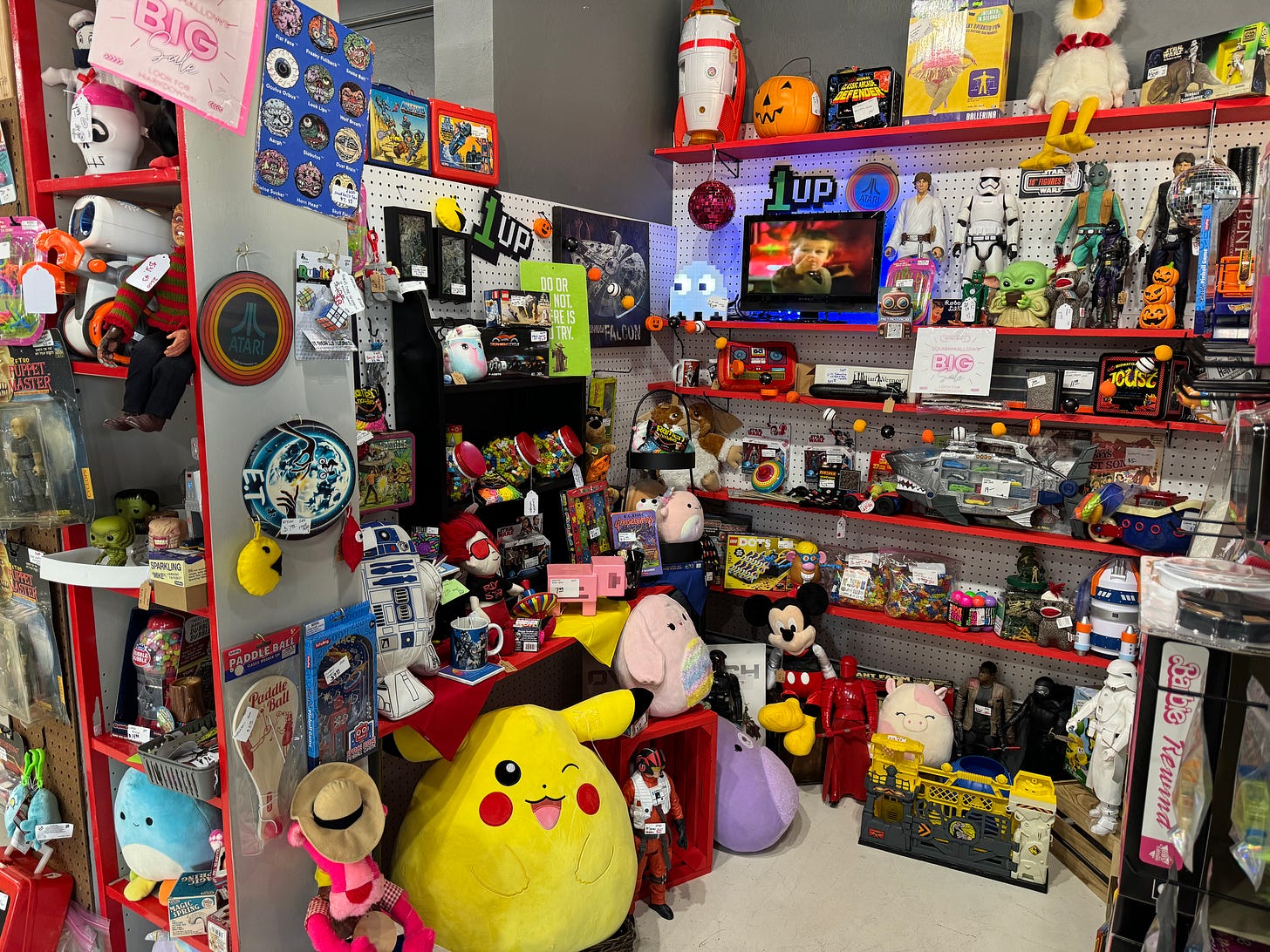
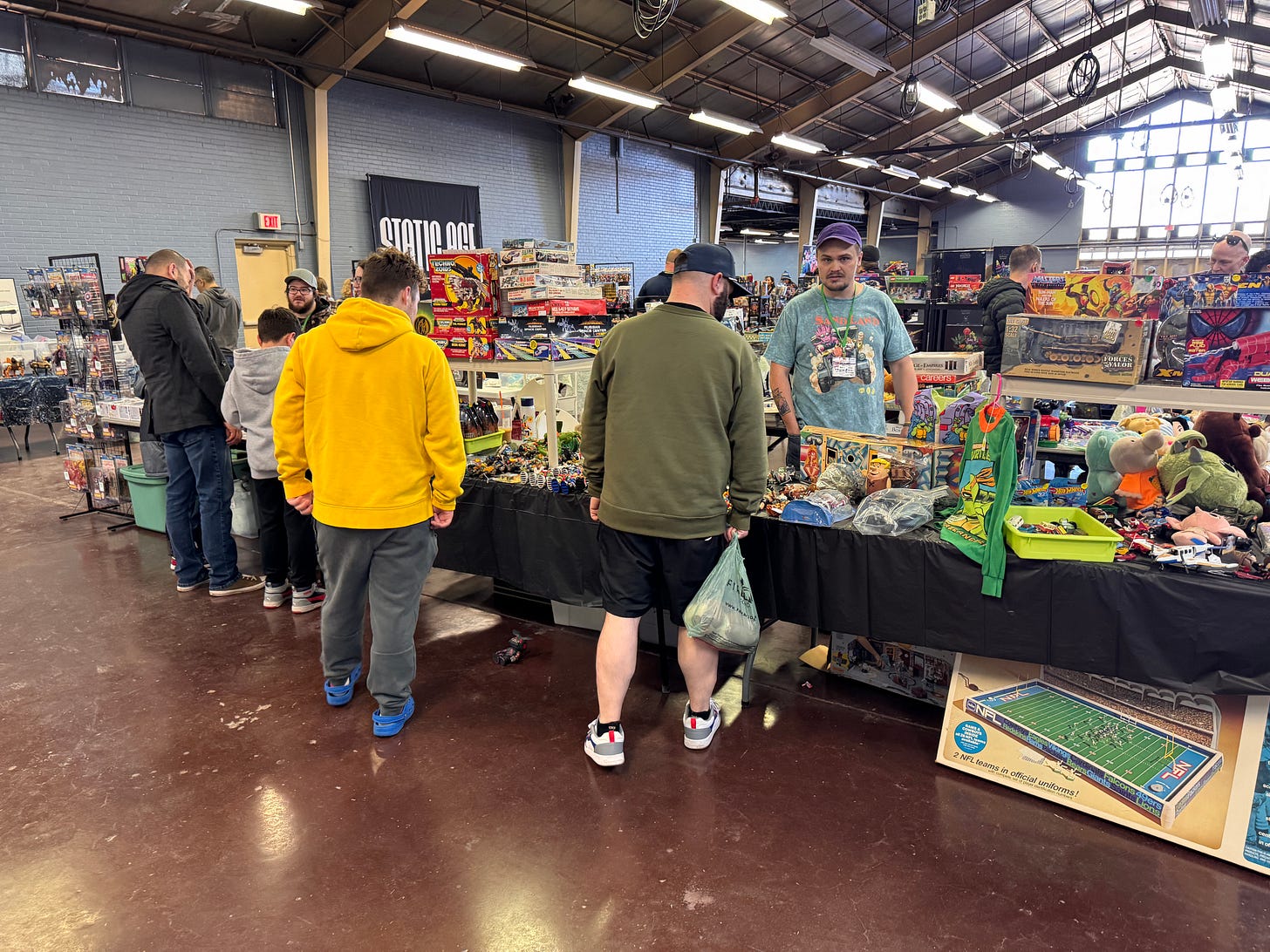
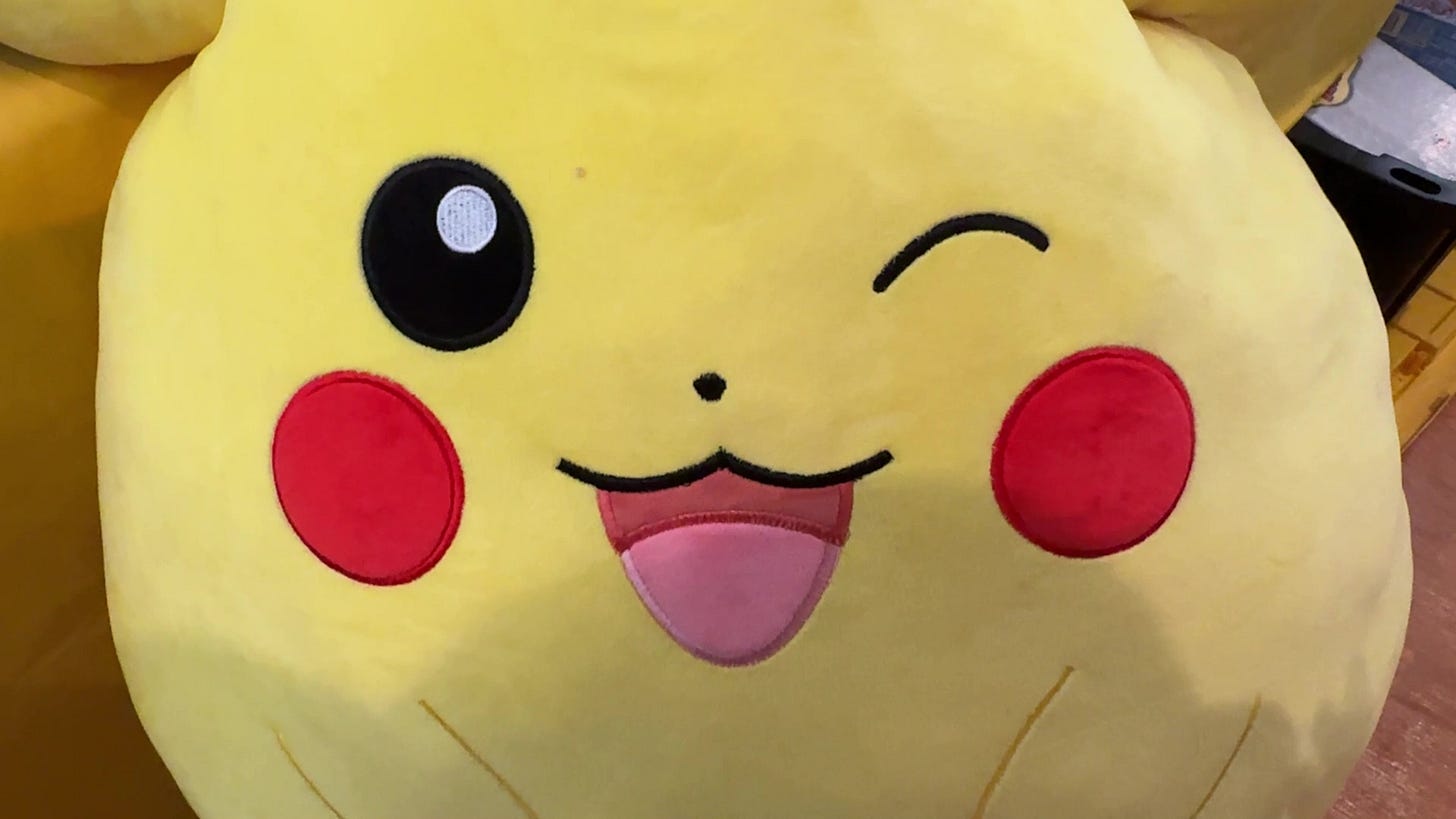


I sold all my original Star Wars toys when I was in high school (‘90), at a flea market, hoping to save up for a computer. Entire box of the Death Star, Yodas swamp, AT-AT, tons of figures including the various with lightsabers extending from their arms, all for $100. Was sad but seemed like a good deal for a bunch of toys I never played with. Ugh. Really wish my parents had the money to afford a computer so I could have held onto them. I still have my comics and you can pry those from my cold dead hands! Daredevil #4 in the yellow suit staying put!
Great article! I wish you had your own shop. Have you seen the Leicester Toy Shop on tour series? Bunch of guys from the UK travel around Europe buying vintage toys. More entertaining than most shows on Netflix: https://youtube.com/@leicestervintagetoyshop?feature=shared